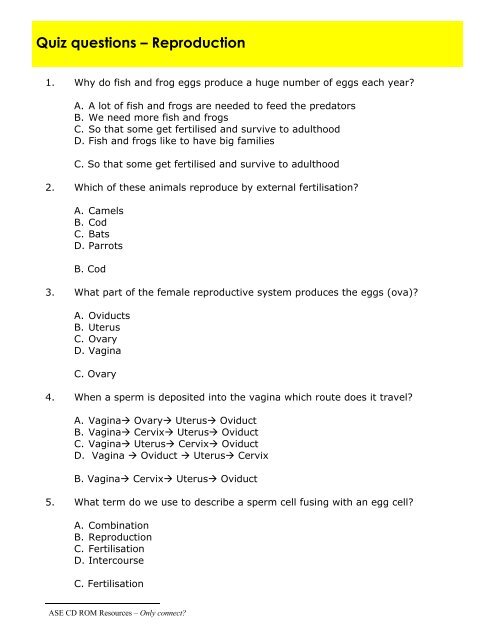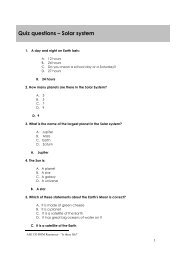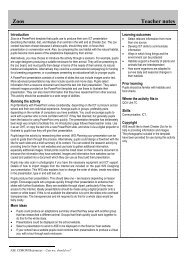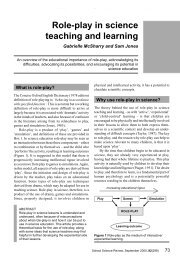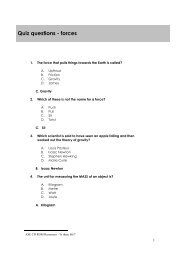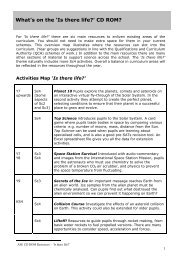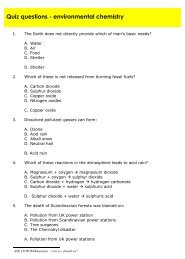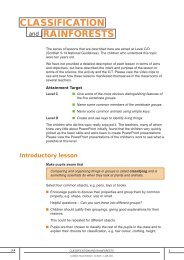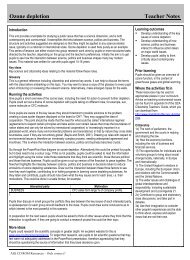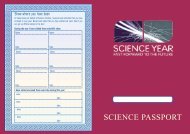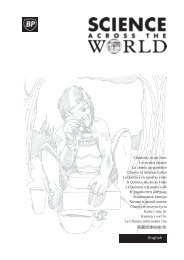Quiz questions – Reproduction - ASE Science Year CD Roms Online
Quiz questions – Reproduction - ASE Science Year CD Roms Online
Quiz questions – Reproduction - ASE Science Year CD Roms Online
Create successful ePaper yourself
Turn your PDF publications into a flip-book with our unique Google optimized e-Paper software.
<strong>Quiz</strong> <strong>questions</strong> <strong>–</strong> <strong>Reproduction</strong><br />
1. Why do fish and frog eggs produce a huge number of eggs each year?<br />
A. A lot of fish and frogs are needed to feed the predators<br />
B. We need more fish and frogs<br />
C. So that some get fertilised and survive to adulthood<br />
D. Fish and frogs like to have big families<br />
C. So that some get fertilised and survive to adulthood<br />
2. Which of these animals reproduce by external fertilisation?<br />
A. Camels<br />
B. Cod<br />
C. Bats<br />
D. Parrots<br />
B. Cod<br />
3. What part of the female reproductive system produces the eggs (ova)?<br />
A. Oviducts<br />
B. Uterus<br />
C. Ovary<br />
D. Vagina<br />
C. Ovary<br />
4. When a sperm is deposited into the vagina which route does it travel?<br />
A. Vagina Ovary Uterus Oviduct<br />
B. Vagina Cervix Uterus Oviduct<br />
C. Vagina Uterus Cervix Oviduct<br />
D. Vagina Oviduct Uterus Cervix<br />
B. Vagina Cervix Uterus Oviduct<br />
5. What term do we use to describe a sperm cell fusing with an egg cell?<br />
A. Combination<br />
B. <strong>Reproduction</strong><br />
C. Fertilisation<br />
D. Intercourse<br />
C. Fertilisation <br />
<strong>ASE</strong> <strong>CD</strong> ROM Resources <strong>–</strong> Only connect?
6. Which part of the male reproductive system produces the sperm cells?<br />
A. Testes<br />
B. Penis<br />
C. Scrotum<br />
D. Sperm duct<br />
A. Testes<br />
7. How are sperm cells adapted for their function?<br />
A. Not having a nucleus to save energy<br />
B. Having sharp teeth to cut into the egg cell<br />
C. Being streamlined to be able to swim faster<br />
D. None of the above<br />
C. Being streamlined to be able to swim faster<br />
8. How does the sperm break through the egg cell membrane?<br />
A. Tears a hole in the membrane<br />
B. Dissolves the membrane with chemicals<br />
C. Bites through the membrane with teeth<br />
D. Squeezes through gaps in the membrane<br />
B. Dissolves the membrane with chemicals<br />
9. Why are egg cells larger than sperm cells?<br />
A. Egg cells have more cells in them<br />
B. Egg cells have a food store to help growth after fertilisation<br />
C. Egg cells have thicker cell membranes<br />
D. Egg cells have larger nuclei<br />
B. Egg cells have a food store to help growth after fertilisation<br />
10. The menstrual cycle prepares the uterus for a fertilised egg. How long is an<br />
average menstrual cycle from start to finish?<br />
A. 20 days<br />
B. 2 weeks<br />
C. 28 days<br />
D. 7 days<br />
C. 28 days <br />
<strong>ASE</strong> <strong>CD</strong> ROM Resources <strong>–</strong> Only connect?
11. What happens to the wall of the uterus during menstruation?<br />
A. It grows and becomes thicker, ready to receive the fertilised egg<br />
B. It is absorbed back into the body<br />
C. It gets thinner and thinner<br />
D. It breaks away and leaves the body through the vagina<br />
D. It breaks away and leaves the body through the vagina<br />
12. At what point in the menstrual cycle is fertilisation most likely?<br />
A. During menstruation<br />
B. Between 12 and 16 days<br />
C. After 20 days<br />
D. Between 25 and 28 days<br />
B. Between 12 and 16 days<br />
13. When the foetus is growing inside the uterus it needs nutrients. What provides<br />
these nutrients?<br />
A. Placenta<br />
B. Amniotic sac<br />
C. Uterus<br />
D. Oviduct<br />
A. Placenta<br />
14. What does the mother’s blood take away from the baby and into the placenta?<br />
A. Oxygen<br />
B. Water<br />
C. Carbon dioxide<br />
D. Food<br />
C. Carbon dioxide<br />
15. What is the job of the amniotic sac?<br />
A. It supports the foetus and protects it from shocks<br />
B. It gives the foetus room to grow and move<br />
C. It provides water for the foetus to drink<br />
D. It stops the baby from drying out<br />
A. It supports the foetus and protects it from shocks <br />
<strong>ASE</strong> <strong>CD</strong> ROM Resources <strong>–</strong> Only connect?
16. Why is vaccination against Rubella important for women?<br />
A. Rubella is dangerous to women<br />
B. Rubella can cause women to become infertile<br />
C. Rubella can cause damage to a growing foetus<br />
D. Rubella will stop a woman from menstruating<br />
C. Rubella can cause damage to a growing foetus<br />
17. Which of these things will affect the way a foetus grows?<br />
A. Chemicals in cigarette smoke<br />
B. Alcohol<br />
C. Drugs<br />
D. All of the above<br />
D. All of the above<br />
18. Why is breast milk important to a newly born baby?<br />
A. It is the right temperature for the baby<br />
B. It is made by its own mother so it is matched to its needs<br />
C. It contains antibodies that protect against common microorganisms<br />
D. It tastes better than bottle milk<br />
C. It contains antibodies that protect against common microorganisms<br />
19. All babies grow rapidly during the first few months. Which of the following is a<br />
factor affecting this difference in growth rate?<br />
A. How well nourished the baby is<br />
B. How big the parents of the baby are<br />
C. Neither A or B<br />
D. Both of A and B<br />
D Both A and B<br />
20. Which of the following is the correct description of the human life cycle?<br />
A. Babyhood, childhood, adolescence, adulthood<br />
B. Childhood, babyhood, adulthood, adolescence<br />
C. Adolescence, babyhood, adulthood, childhood,<br />
D. None of these<br />
A. Babyhood, childhood, adolescence, adulthood <br />
<strong>ASE</strong> <strong>CD</strong> ROM Resources <strong>–</strong> Only connect?


